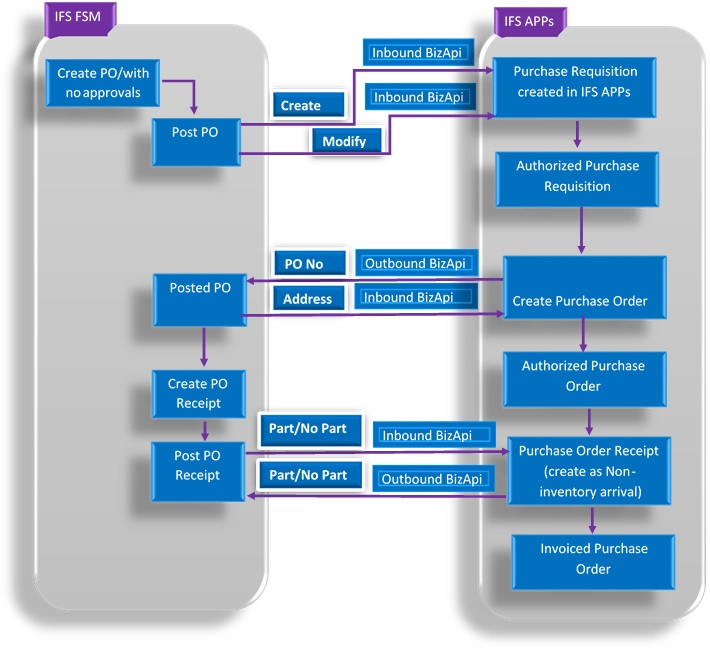
The main objective is to integrate IFS Field Service Management (FSM) purchase order with IFS Applications purchase order. The purchase order initiated in FSM is passed into IFS Applications with the new demand code Field Service Management (FSM).
The process diagram shown below illustrates these processes:

When the purchase order is posted in FSM, it triggers the CREATE_PURCHASE_REQUISITION inbound BizAPI to create the purchase requisition in IFS Applications, with the new system defined Requisitioner FSM and demand code Field Service Management (FSM). If supplier for purchase part record does not exist, then it will be created by using the supplier and price information from FSM purchase order.
All functionalities connected to purchase requisition flow are not provided for FSM demands due to less prioritization of requirements and time constraints. Therefore, the following processes and views are restricted for FSM demands in IFS Applications:
When a user releases the purchase requisition, it will trigger the authorization. Then the user can authorize the particular purchase requisition.
In IFS Applications, the user can modify the existing purchase order details such as Quantity, Date (promised delivery date and wanted delivery date is passed into FSM) and Price (prices in base currency is passed into FSM) fields. Then trigger the SEND_PURCHASE_ORDER_DETAILS outbound BizApi to pass the modification into FSM purchase order. After creating the purchase order in IFS Applications all changes go through the Application, not through FSM.
User cannot delete IFS purchase order line for FSM demands.
From FSM side address information is passed into IFS Applications which is then considered as a single occurrence address in IFS Applications purchase order.
In IFS Applications, once the purchase order gets released then the user can handle the purchase order receipts via Register Purchase Order Arrivals window for part and no-part lines. Then trigger the RECEIVE_PO_PART_LINES and RECEIVE_PO_NO_PART_LINES inbound BizAPIs to execute purchase order receipts from FSM automatically. The FSM demand purchase order in IFS Applications is treated as a non-inventory receipt since inventory balances are only tracked in FSM and financial transactions in IFS Applications.
When the inventory purchase order receipt occurs the following transactions are created:
| System Event ID | System Event Description | Comments |
| FSMPRDIFF+ | FSM Price Difference - Higher Price | If there is a higher price difference against the part cost vs purchase price. |
| FSMPRDIFF- | FSM Price Difference - Lower Price | If there is a lower price difference against the part cost vs purchase price. |
| FSMARRIVAL | FSM purchase order receipt for inventory Part | Purchase order receipt for inventory part. |
All functionalities connected to purchase order receipt flow are not provided for FSM demands due to less prioritization of requirements and time constraints. Therefore, the following processes and views are restricted for FSM demands in IFS Applications:
FSM purchase order receipt is relevant to standard cost. Therefore, the standards are compared to actual costs whereas variances are computed and posted (FSMPRDIFF+ or FSMPRDIFF-).
In IFS Applications, once the purchase order receipt is generated then the user can create the supplier invoice.
The inventory purchase order receipt is used to post preliminary cost. When the supplier invoice arrives, it is matched against the receipts to ensure that you only get invoiced for the items received and any purchase price variances are handled during the matching process.
Handled self-billing functionality for:
The user can use posting proposals functionality where the supplier invoices will be automatically matched against the purchase order receipts. It is possible to authorize posting proposals in line with the standard functionality. When making a final posting of a posting proposal, then the relevant data is transferred correctly back to the supplier invoice.